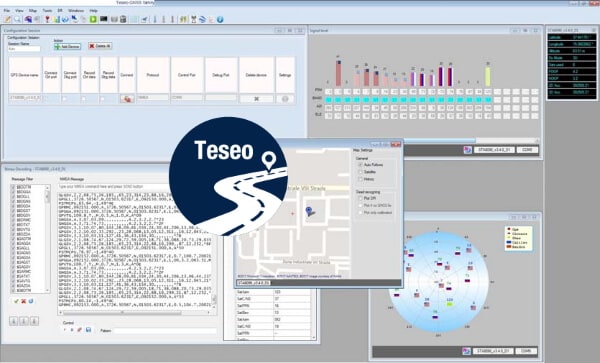The easiest solution for Automotive Dead Reckoning applications
An easy-to-use, standalone dead-reckoning Global Navigation Satellite System (GNSS) module with a built-in 6-axis inertial sensor, the Teseo-VIC3DA offers many extra features including 7-day Autonomous Assisted GNSS, Predictive Assisted GNSS and Real-Time Assisted GNSS. Thanks to its embedded Flash memory, this automotive-grade positioning module supports firmware configurability as well as firmware upgrades. A complete development environment ecosystem is available.
Key features of TESEO-VIC3DA
- AEC-Q100 qualified
- Simultaneous multi-constellation positioning
- Teseo dead-reckoning automotive way firmware (Teseo-DRAW)
- -163 dBm sensitivity tracking
- 1.5 m CEP accuracy positioning
- Automotive GNSS module with an embedded 6-axis inertial sensor (IMU)
- 24-pin ceramic leadless chip carrier (LCC) package (16.0 x 12.2 x 2.42 mm)
- Operating temperature (from -40 to +85 °C)
Application examples
How to test & prototype with TESEO-VIC3DA
Choose a development kit and software to start testing the capabilities and features of TESEO-VIC3DA:
EVB-VIC3DA
Complete standalone evaluation platform for solutions based on the Teseo-VIC3DA dead-reckoning GNSS module.
TESEO-SUITE
A feature-rich PC software suite, TESEO-SUITE lets developers manage several Teseo GNSS solutions in parallel.
Teseo-VIC3DSW
Latest firmware for the Teseo-VIC3DA dead-reckoning GNSS module.
Newsbite Oct-25th 2021
STMicroelectronics' automotive-qualified GNSS navigation module with dead reckoning simplifies design and boosts performance
How to easily implement GNSS positioning in your IoT design
Learn how Teseo modules use multi-constellation GNSS signals and dead-reckoning to enable high-accuracy positioning in a wide range of IoT applications.
Webinar overview
- What GNSS means and why multi-constellation is beneficial
- The key advantages of the Teseo-LIV3FL and Teseo-VIC3D/DA modules
- How to calibrate and leverage dead-reckoning (DRAW/DRUM)
- Tips on how to ensure your hardware design is optimized from the beginning






